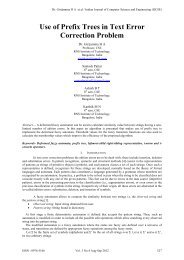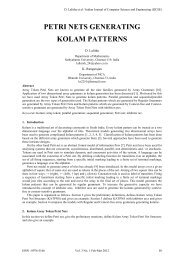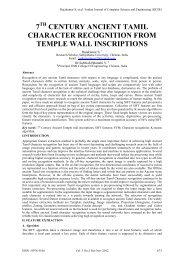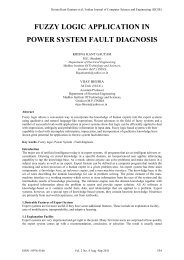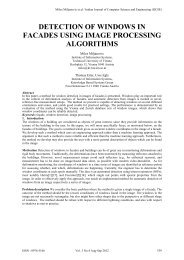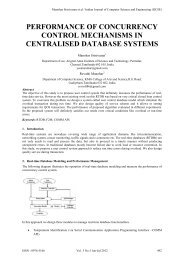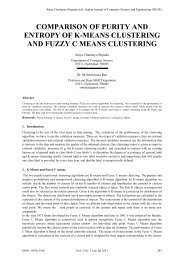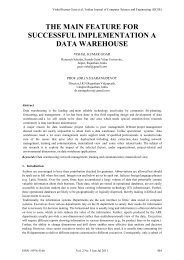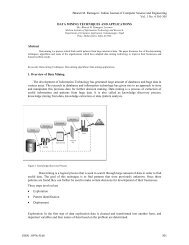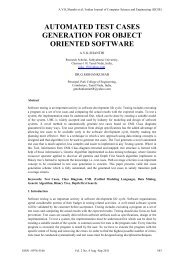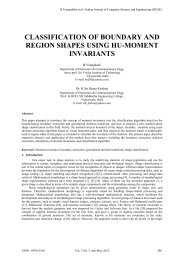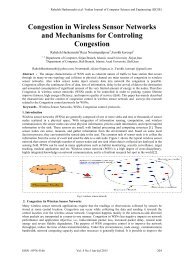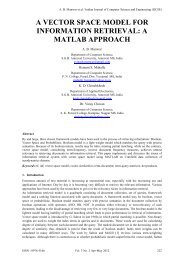adapting rule based machine translation from english to bangla
adapting rule based machine translation from english to bangla
adapting rule based machine translation from english to bangla
You also want an ePaper? Increase the reach of your titles
YUMPU automatically turns print PDFs into web optimized ePapers that Google loves.
Judith Francisca et al./ Indian Journal of Computer Science and Engineering (IJCSE)ADAPTING RULE BASED MACHINETRANSLATION FROM ENGLISH TOBANGLAJUDITH FRANCISCA *Computer Science & Engineering Department, United International University,House # 80, Road # 8/A, Dhaka-1209, Bangladeshjudithfran@gmail.comhttp://MD. MAMUN MIAComputer Science & Engineering Department, United International University,House # 80, Road # 8/A, Dhaka-1209, Bangladeshmd.mamunmia@gmail.comhttp://DR. S. M. MONZURUR RAHMANComputer Science & Engineering Department, United International University,House # 80, Road # 8/A, Dhaka-1209, Bangladeshmrahman99@yahoo.comhttp://AbstractKeywords: Machine Translation; Natural Language Processing; Language Translation; Artificial Intelligence; Knowledge RepresentationSystem.1. Introduction* Present address of the author.This paper presents the <strong>adapting</strong> <strong>rule</strong> <strong>based</strong> <strong>machine</strong> <strong>translation</strong> <strong>from</strong> English <strong>to</strong> Bangla. The proposed language <strong>translation</strong> model relies on<strong>rule</strong> <strong>based</strong> methodologies especially fuzzy <strong>rule</strong>s. There are “If - Then” basis <strong>rule</strong>s are applied for the English <strong>to</strong> Bangla language <strong>translation</strong>.In this language <strong>translation</strong>, we use rough set technique for Knowledge Representation System. This technique is used <strong>to</strong> classify eachEnglish sentence <strong>to</strong> a particular class using attributes of that English sentence and then translate them <strong>to</strong> the Bangla sentence using the <strong>rule</strong>sthat is produced earlier in the language <strong>translation</strong> system. Here English <strong>to</strong> Bangla bilingual dictionary has been formed for the purpose oflanguage <strong>translation</strong>.Bangla (can also be termed as Bengali) is one of the richest languages among all the languages exist in theworld and one of the largely spoken languages in the world. More than 220 million people speak in Bangla astheir native language. It is ranked sixth <strong>based</strong> on the number of speakers [1]. Bangla is the mother language ofBangladesh and also a large number of people in eastern area of India (West Bengal and Kolkata as its capital)speak and write in Bangla. The written Bangla was found approximately 650 A. D. But during 1500 B. C. <strong>to</strong>1000 B. C. there was a language called “Shangskrit” (ms¯‹…Z) which was used only by the upper level peopleof the society and was used only for literature. And the local people used “Aarjo” (Avh©) of “Adim Prakri<strong>to</strong>”(Avw`g cÖvK…Z). However, there were more than one type of “Adim Prakri<strong>to</strong>” language and one of them was“Pali” (cvwj). “Pali” was changed <strong>to</strong> “Praccho Prakri<strong>to</strong>” (cÖvP¨ cªvK…Z) and then <strong>to</strong> “Gouro Prakri<strong>to</strong>” (‡MŠocªvK…Z). Then, the next stage is “Gouro Opovrongsho” (‡MŠo Acåsk). And <strong>from</strong> this “GouroOpovrongsho” the language Bangla was created [2]. Bangla is a member of the Indo-Aryan languages. It isderived <strong>from</strong> Sanskrit. It is written left-<strong>to</strong>-right, <strong>to</strong>p-<strong>to</strong>-bot<strong>to</strong>m of page (same as English). Its vocabulary is akin<strong>to</strong> Sanskrit. Though the vocabularies are quite difficult at first, but <strong>to</strong> some extent there are similarities withLatin as exemplified by the following words in Table 1.ISSN : 0976-5166 Vol. 2 No. 3 Jun-Jul 2011 334
Judith Francisca et al./ Indian Journal of Computer Science and Engineering (IJCSE)Table 1: Comparison of the similarities between different languages.LanguageWordEnglish month mother new night nose threeLatin mensis mater novus nox nasus tresSanskrit mãs matar nava nakt nãs trayasBangla Mash mata nobo ratri naakh tinNatural Language Processing (NLP) is quite a difficult task. There were many researches in the field oflanguage <strong>translation</strong> but there is no fully successful language <strong>translation</strong> <strong>machine</strong> so far. Since it is a HumanLanguage Technology (HLT), there are lots of varieties and lots of opportunities for research. It is not possible<strong>to</strong> work on the whole language <strong>translation</strong> process <strong>to</strong>gether. Therefore, it is segmented in<strong>to</strong> many parts. But, thefact is, most of them choose a part of the source language <strong>to</strong> be translated <strong>to</strong> the target language. For example, inour paper the source language is English and the target language is Bangle. There are varieties types ofsentences both in English and Bangla language. In this paper, we have kept all types of sentences though thetypes of sentences are not the main issues of our thesis. We have mainly focused on the process of language<strong>translation</strong> and the effectiveness of the language <strong>translation</strong>. The efficiency is measured by different methods. Inthis paper, we can adapt a new system so that it will be 100% efficient at least theoretically.The paper is organized as follows: Section II discusses the background of the research. Section III explainsthe problem statements. Solution Frameworks are analyzed in Section IV, while the methods for improving <strong>to</strong>the adaptive system are provided in Section V. Finally, Section VI draws some conclusion and provides someremarks on the future works.2. BackgroundA very few work has been done on English <strong>to</strong> Bangla language <strong>translation</strong> both in Bangladesh andWest Bengal of India. A hybrid scheme is shown in [3]. Only the present indefinite and present continuousforms of English sentences are concerned in [4]. They represent a simple algorithm for language <strong>translation</strong>.Using Artificial Intelligence (AI) a Natural Language Processing (NLP) algorithm is proposed in [5]. In [6],Cockey-Younger-Kasami (CYK) algorithm is used for language <strong>translation</strong>. The main change they brought wasthat they used normal parse tree than the Chomsky Normal Form (CNF) parse tree because they proved thatsome problems arose during transfer <strong>from</strong> English parse tree <strong>to</strong> Bangla parse tree. Fig. 1 shows pars tree forEnglish and Bangla sentence. Morphological analysis is done in [7] where morphemes means minimal unit ofmeaning of grammatical analysis. A phrasal Example Based Machine Translation (EBMT) is represented in [8].Another paper [9] concentrated specially on prepositions of English. In other languages, excluding Bangla it isinteresting <strong>to</strong> study Machine Translation (MT) because it will show some other efficient techniques for language<strong>translation</strong>. This type of research is Spanish <strong>to</strong> English language <strong>translation</strong> [10]. Using five (5) components andthree (3) algorithms they have done the language <strong>translation</strong>. Components are i) PENMAN Upper Model, ii)ONTOS Model, iii) Longman’s Dictionary of Contemporary English (LDOCE), iv) WordNet, v) Harper CollinsSpanish English Bilingual Dictionary.Figure 1: Parse tree for English and Bangla sentence.ISSN : 0976-5166 Vol. 2 No. 3 Jun-Jul 2011 335
Judith Francisca et al./ Indian Journal of Computer Science and Engineering (IJCSE)3. Problem StatementBefore knowing that how the language <strong>translation</strong> works we need <strong>to</strong> understand both the structure of Englishand Bangla language. The methods of language <strong>translation</strong> are depended on the structure of sentence andgrammar of the each language.3.1 Grammatical Analysis for English and Bangla LanguageAnalysis of English grammar is a huge task. But we have analyzed only those things which are essential for ourlanguage <strong>translation</strong>. These are verbs, phrase, prepositions and Bivokti (Inflection).Verbs are the most important term in grammar. Using the verb we can identify the tense of a sentence. Inour language <strong>translation</strong> we omit auxiliary verb and joining with the subsequent verb we make a verb phrase.This is done because there is no direct use of auxiliary verb in Bangla sentence. For example the Englishsentence, “I am going <strong>to</strong> school” has two verbs, “am” is the auxiliary verb and “going” is the subsequent verb inthis sentence. It will be considered only one verb like “am going”. Here “am” is translated in Bangla as“nq/nB” (hoy/hoi) which is not used in Bangla sentence. So the dictionary is also developed in this way. This“am going” is considered as verb phrase. In the same way “<strong>to</strong>” and “school” also merged as “<strong>to</strong> school” andconsidered as noun phrase. Here “school” and “<strong>to</strong> school” are translated differently in Bangla sentence. InBangla sentence “school” is translated as “¯‹zj” (school) and “<strong>to</strong> school” is translated as “¯‹z‡j” (schoole).This “‡” (e) is called Bivokti in Bangla grammar. Bivokti means a single letter or more than one letter which isadded after the noun <strong>to</strong> make relation with the other words of the sentence. Since there is no existence of Bivoktiin English grammar different phrases and also different prepositions are translated as Bivokti in Banglasentence. For example “I am sleeping in my room” will be translated as “Avwg Avgvi N‡i Nygvw”Q” (amiamar ghore ghumachchhi). Here “in” is translated as “‡” (e) and added after the noun “room” as “N‡i” (ghor +e = ghore). The issue is preposition. There is no use of preposition in Bangla grammar. Prepositions aretranslated as Bivokti in Bangla. Sometimes prepositions are considered as prepositional phrase and thentranslated. The dictionary has <strong>to</strong> be rich enough <strong>to</strong> handle prepositions.3.2 Comparative structure between English and Bangla LanguageFor the sake of language <strong>translation</strong> <strong>from</strong> English <strong>to</strong> Bangla we need <strong>to</strong> discuss a comparative structure inbetween these two languages. It will help us <strong>to</strong> understand about the major problems for language <strong>translation</strong>.Here, we have described the sentence patterns of these two languages at first. And then we have described thegrammar patterns of these two languages. Later, we have compared these patterns for both English and Banglalanguage.Generally sentences are divided in<strong>to</strong> three parts: i) Simple Sentence, ii) Complex Sentence and iii)Compound Sentence. Compound Sentence can also divide in<strong>to</strong> Double and Multiple Sentence. Here we give anexample of Simple Sentence. For English pattern: p1: Subject + Verb + Object (should have one subject and onefinite verb). Example – He plays football (He + plays + football). For Bangla pattern: ~ p1: Subject + Object +Verb. Example – ‡m dzUej †L‡j (she football khale) {‡m+dzUej+†L‡j (she+football+ khale)}.A grammatical analysis is needed <strong>to</strong> produce <strong>rule</strong>s for language <strong>translation</strong>. Both English and Bangla havetheir own grammars and we need the proper mapping <strong>from</strong> English grammar <strong>to</strong> Bangla grammar. For instance,the English grammar and Bangla grammar for a particular sentence is illustrated here. English grammar for thesentence, “I washed my hands and face” is stated below.n + v + (d + n′ + c + n ′ )n → Head Noun, v → Verb, d → Determiner, n′ → Noun 1, c → Conjunction, n ′ → Noun 2Noun → I | Karim | Rahim, Verb → washed | wash, Determiner → my | all | some, Noun 1 → hands,Conjunction → and | or, Noun 2 → faceBangla grammar for the corresponding Bangla sentence, “Avwg Avgvi nvZ Ges gyL ayBjvg” (Amiamar hat ebong mukh dhuilam) is given below.ISSN : 0976-5166 Vol. 2 No. 3 Jun-Jul 2011 336
Judith Francisca et al./ Indian Journal of Computer Science and Engineering (IJCSE)n + (d + n′ + c + n ′ ) + vn → Head Noun, v → Verb, d → Determiner, n′ → Noun 1, c → Conjunction, n ′ → Noun 2Noun → Avwg (ami) | Kwig (korim) | iwng (rohim), Verb → ayBjvg (dhuilam) | ‡avqv (dhoa), Determiner→ Avgvi (amar) | mevB (shobai) | wKQz (kichhu), Noun 1 → nvZ (hat), Conjunction → Ges (ebong) |A_ev (othoba), Noun 2 → gyL (mukh)A morphological analysis is done while mapping <strong>from</strong> English <strong>to</strong> Bangla grammar. It is essential <strong>to</strong>compare the two grammar structure for proper language <strong>translation</strong>. The dissimilarities between the twolanguages are the main problems of language <strong>translation</strong>. We have already discussed some of them. Theauxiliary verb and prepositions of English grammar are not found in Bangla grammar. On the other hand,Bivokti does not exist in English grammar. This problem is solved by making auxiliary verb as verb phrase.Here, auxiliary verbs are considered as verb phrase that is added with the subsequent verb of the sentence.Prepositions are translated as prepositional phrase or Bivokti that is adding one or more than one letter at postposition after the noun in Bangla sentence.4. Solution FrameworkIn our research we have concentrated on <strong>rule</strong>s those have been assigned by us for proper language <strong>translation</strong><strong>from</strong> English <strong>to</strong> Bangla. We have taken a set of English sentences and translate them in<strong>to</strong> Bangla sentences astraining set. Afterwards, we have taken a testing set <strong>to</strong> measure the efficiency of our system.4.1 Flow Diagram of the Translation ArchitectureThe flow diagram of the language <strong>translation</strong> architecture is shown in Fig. 2. There are different blocks whichrepresents different steps of the language <strong>translation</strong> process. First of all, an English sentence is constructed withwords and is ended commonly with a full s<strong>to</strong>p (“.”). The first task of the transla<strong>to</strong>r is <strong>to</strong> split each word. Butsplitting doesn’t mean that all are distinct and have no connection with each other. Attributes are the informationof that word. Using these attributes the transla<strong>to</strong>r will analyze that word lexically. Lexical analysis is done forunderstanding the grammatical and sentence structure of that sentence. Using the attributes <strong>from</strong> the dictionarythe sentence is then classified. The result of the Lexical Analyzer is <strong>to</strong> generate the class of that sentence. Sincethe previous step finds the class of the English sentence in this step a searching method is done. The target ofthis method is <strong>to</strong> find out the matched fuzzy <strong>rule</strong> (r) for the English sentence. It might be happened that a <strong>rule</strong> ismatched fully or partially. Both are in concern because those are partially matched will produce a partialtranslated Bangla sentence. It is better than <strong>to</strong>tally void result. Moreover, we can enrich the Knowledge Based<strong>rule</strong>s of the <strong>machine</strong> while facing the partial searching result.In the next step the dictionary will be used for finding the corresponding Bangla words. Here morphologicalanalysis is done. It is necessary <strong>to</strong> analyze that which word meaning is needed in which place. The meaningshould be appropriate and correct. Accuracy is the big measurement of the efficiency. For taking the rightdecision and choosing the right word we have used the various attributes of that English word <strong>from</strong> thedictionary. The final task is <strong>to</strong> reconstruct the Bangla sentence. It is already half done in the second step. Wehave found the matched production <strong>rule</strong> (r) for the English sentence. Now, <strong>from</strong> the production <strong>rule</strong> table thecorresponding <strong>rule</strong> (r') for the Bangla sentence is found. According this <strong>rule</strong> (r') the final result of the transla<strong>to</strong>rhas been provided.ISSN : 0976-5166 Vol. 2 No. 3 Jun-Jul 2011 337
Judith Francisca et al./ Indian Journal of Computer Science and Engineering (IJCSE)4.2 AlgorithmFigure 2: Flow Diagram of English <strong>to</strong> Bangla Transla<strong>to</strong>r.ISSN : 0976-5166 Vol. 2 No. 3 Jun-Jul 2011 338
Judith Francisca et al./ Indian Journal of Computer Science and Engineering (IJCSE)4.3 Production RulesWhile translating the training set we have produced a set of <strong>rule</strong>s. These <strong>rule</strong>s are stated in Table 2. These <strong>rule</strong>sare extendable. The more the training set sentences the more the <strong>rule</strong>s can be added as required. In the table,there are production <strong>rule</strong>s represented. We have showed the production <strong>rule</strong>s for both English and the Banglasentences side by side. There are individual sentence patterns for English and Bangla sentences. We have beenrepresented here all the English sentence patterns as r and all the Bangla sentence patterns as r' in common.These <strong>rule</strong>s are in pair wise. Because a sentence pattern in English must have a corresponding sentence patternin Bangla which is used for language <strong>translation</strong>. These <strong>rule</strong>s are predefined and must be precisely given in thelanguage <strong>translation</strong> system. For the language <strong>translation</strong> purpose, an English sentence pattern will change <strong>to</strong> aBangla sentence pattern according <strong>to</strong> a particular <strong>rule</strong>. This <strong>rule</strong> is given in the production <strong>rule</strong> table. In this tablethere are very few <strong>rule</strong>s represented <strong>to</strong> give the idea that how the production <strong>rule</strong> works. All the <strong>rule</strong>s arenumbered and each pair is in the same number. For example, if an English sentence pattern represents r 3 , thenthe Bangla sentence pattern for particularly r 3 will be r' 3 . So, r n sentence pattern for English sentence will havethe r' n sentence pattern in Bangla in the production <strong>rule</strong> table.4.4 DatabaseSince we needed a dictionary, it was manda<strong>to</strong>ry <strong>to</strong> use a digital dictionary. A flat file has been used asdictionary. Here different attributes have been given for finding out the classification and each result has been ina definite class. These are the information about the words. This information has been used <strong>to</strong> classify thesentence. There are more than 200 words generated in the dictionary. It is expandable <strong>to</strong> as much as we need.The more the sentences are applied <strong>to</strong> the model the more the dictionary will be enriched. Both for training andtesting sets, the dictionary is enhanced with the words along with the attributes.Table 2: Generated <strong>rule</strong>s for language <strong>translation</strong>.English Pattern ( r )PRODUCTION RULESBangla Pattern ( r′ )r s → n + v + n′r′ s → n + n′ + v12Salma + was peeling + pota<strong>to</strong>esr s → n + v + n′ + n ′r3r4r5r6r7Knowledge + lights + the way + <strong>to</strong> heavenp + art + adj + nIt + is a + costly + penp + vWe + were playingn + vThe moon + shinesp + d + vWe + all + breathed + art + nThis + is a + picturer 8n + v + (p + n′ )aKarim + cut + (his + finger)r 8n + v + (p + art + adj + n′ )bc12mvjgv + Avjyi + †Lvmv Qvovw”Qjr′ s → n + n ′ + n′ + vr′3r′4r′5r′6r′7r 8′ar 8′Ávb + †e‡nk&‡Zi + c_wU + Av‡jvwKZ K‡ip + art + adj + nGUv + GKwU + `vgx + Kjgp + vAvgiv + †Ljv KiwQjvgn + vPuv` + wKiY †`qp + d + vAvgiv + mevB + wbtk¦vm †bBd + art + nGUv + GKwU + Qwen + (p + n′ ) + vKwig + (Zvi + Av½yj) + †K‡UwQjn + (p + art + adj + n′ ) + vbGrandfather + <strong>to</strong>ld + (us + a + funny + s<strong>to</strong>ry) `v`vRvb + (Avgv‡`i + GKwU + gRvi + Mí) +e‡jwQjr 8n + v + ( n′ + adv)dHabib + goes + (<strong>to</strong> college + regularly)′ )r 8n + v + (d + n′ + c + n ′I + washed + (my + hands + and + face)r 8′cdn + ( n′ + adv) + vnvwee + (K‡j‡R + wbqwgZ) + hvq′ ) + vr 8′ n + (d + n′ + c + n ′Avwg + (Avgvi + nvZ + Ges + gyL) + ayBjvgISSN : 0976-5166 Vol. 2 No. 3 Jun-Jul 2011 339
Judith Francisca et al./ Indian Journal of Computer Science and Engineering (IJCSE)r 9 abp + v + nI + eat + ricer 9p + v + (n + p′ )cHe + <strong>to</strong>ld + the news + <strong>to</strong> everyoner 9p + v + (n + d + n′ )r 9 dWe + visited + (Moynamoti + last + year)p + v + advHe + was sleeping + thenr p + n + v + pre + d + p′ + n′10r11Each + Muslim + is brother + of + every + other+ Muslimv + p + d + adj + nGive + him + some + crisp + pota<strong>to</strong>-chipsr 9′ar 9′br 9′cr 9′d10P + n + vAvwg + fvZ + LvBp + (n + p′ ) + v‡m + (msev`wU + mevB‡K) + e‡jwQjp + (n + d + n′ ) + vAvgiv + (gqbvgwZ + MZ + eQi) + †`‡LwQjvgp + adv + v‡m + ZLb + Nygvw”Qjr′ p + n + pre + d + p′ + n′ + vr′11GK + gymjgvb + cÖ‡Z¨K + Aci + gymjgvb + Gi +fvBp + d + adj + n + vZv‡K + wKQz + gP&g‡P + Avjy fvRv + `vI4.5 Programmatic SolutionTo implement the theory that we have stated earlier, we needed <strong>to</strong> create a program. To create a program we had<strong>to</strong> write a set of instructions. These instructions are called programmatic codes. These programmatic codes areusually written in some special languages such as C, Java and VB etc. We have used Java as our programminglanguage. Initially it is required <strong>to</strong> <strong>to</strong>kenize the words <strong>from</strong> the English sentence. This means each word is a<strong>to</strong>ken in a sentence. We need <strong>to</strong> detach all the words. This process is called <strong>to</strong>kenizing. This <strong>to</strong>kenizing processis done by split( ) method. This splits all the words separately. One part of coding is used for defining phrases ofthe English sentences. In grammar there are different types of phrases. For this we need <strong>to</strong> define all the phrasesand find out which phrase is appropriate for the particular sentence. Then we need <strong>to</strong> find out the correspondingBangla word <strong>from</strong> the dictionary. In this part, each word of the English sentence is searched in the dictionary formatching. When the matched word is found all the information of that word is collected for analysis. Thisinformation is termed as attributes. These attributes are used <strong>to</strong> find out the fuzzy <strong>rule</strong>s of the particularsentence. There is also a calculation of probability of finding out the words in dictionary. A percentage ofsearching result is showed in this program. It shows the rate of successful searching result.4.6 ExperimentIn the experiment we use two data sets. One is training data set and the other is testing data set. The model isbuilt with the sentences of training data set. Afterwards, the sentences of testing data set are used for calculatingthe efficiency of the model.4.7 Error EstimationTo estimate the error different types of method can be used. We have used three methods for error estimation.These are: i) Hold Out, ii) Cross Validation (Leave one out) and iii) Bootstrap. In hold out method 2/3 of thedata is used for training set and 1/3 data is used for testing set. We selected data for testing set randomly. In thiscase we have taken 79 sentences as training data set and 27 sentences as testing data set. Among the 27sentences of testing data set 25 sentences are translated correctly without any error. Two sentences are foundincorrectly translated. These two sentences are 75% and 33% correct respectively. In cross validation methodthe data set is divided in<strong>to</strong> subsets of approximately equal sizes. Each time one subset is leave out for testing andall other subsets are used as training data set. In our experiment we have taken 8 fold data that is there are 8subsets. So the model is executed 8 times. Each time the error rate is calculated in testing data set. The finalerror rate is found by calculating the average of all the error rates. The sampling size is 10. Total 79 sentencesare taken. Since it is not divisible by 10, only the last fold contains 9 sentences. The bootstrap is <strong>based</strong> on thestatistical procedure of sampling with replacement. The previous methods were sampled without replacement <strong>to</strong>built training or testing set. In the bootstrap method the testing set is selected randomly <strong>from</strong> subsets byreplacement. The formula of this method isISSN : 0976-5166 Vol. 2 No. 3 Jun-Jul 2011 340
Judith Francisca et al./ Indian Journal of Computer Science and Engineering (IJCSE)e =1nni=10.632 * E1 + 0.368*E2…………………………………………………….………. (1)Where, e = Error rate, n = Sampling size,E 1=Error on the testing data set,E 2=Error on the trainingdata set and i = Number of iteration.Training set will contain about 63.2% with size n whereas the testing set will contain only 36.8%. HereSampling size is 10 that is n = 10 and the samples are taken 10 times with replacement, that is i = 10. The erroron the training data set is zero that is4.8 Comparison of the MethodsE 2=0.We needed <strong>to</strong> compare in<strong>to</strong> different learning methods on the same problem data set <strong>to</strong> see which one is better<strong>to</strong> use. To find out the best method we have <strong>to</strong> estimate the error using several methods and the method whichresults the smallest value of error estimation is the best method. Comparing among all the above three methodsthe bootstrap method is the best. It gives the smallest error estimation shown in Fig 3.5. Improving <strong>to</strong> the Adaptive SystemFigure 3: Comparing Chart among Three Methods.It is necessary <strong>to</strong> improve the system by <strong>adapting</strong> some techniques so that it can be performed with higherefficiency. Here, we would like <strong>to</strong> improve the system <strong>to</strong> make an errorless transla<strong>to</strong>r. It is almost impossible <strong>to</strong>generate a cent percent correct transla<strong>to</strong>r. But we should give a try <strong>to</strong> improve the system.5.1 Adaptive SystemAn adaptive system adapts <strong>to</strong> the new conditions of the previous system. Adaptive System refers <strong>to</strong> the changeof the conditions that are created in preceding system. The adaptive system either adjusts its set of <strong>rule</strong>s byexample or that develops gradually in<strong>to</strong> a new system which adjusts its set of <strong>rule</strong>s by using any ways [11]. By[12] there are four components of adaptive systems.5.2 Different ways of AdaptationAdaptation can be taken in different ways <strong>to</strong> update the model like, i) Increasing the data set, ii) Increasing thenumber of <strong>rule</strong>s, iii) Merging the previous unnecessary <strong>rule</strong>s, iv) Increasing the number of attributes indictionary and v) Applying the preferences.ISSN : 0976-5166 Vol. 2 No. 3 Jun-Jul 2011 341
Judith Francisca et al./ Indian Journal of Computer Science and Engineering (IJCSE)5.3 Error Estimation in Adaptive SystemIt is very interesting <strong>to</strong> observe the difference between non adaptive and adaptive system. There is significantdifference between the results of the two systems. The error estimation for both the non adaptive and theadaptive system are done by the same process, using the same methods as described in Section 4.7. The previoustesting data set is merged with the previous training data set. New testing data set is taken for the comparison ofthe two systems. Comparison between non adaptive and the adaptive system are shown in Table 3.Table 3: Comparing the Non Adaptive and the Adaptive System.MethodsSystemsPrevious Testing Data SetNon Adaptive(Errors in %)Non Adaptive(Errors in %)New Testing Data SetAdaptive(Errors in %)Hold Out 3.3951 2.1826 1.5874Cross Validation 1.895875 1.1787 0.9802Bootstrap 1.5379088 0.8544 0.76666. ConclusionIn this paper, we have shown a <strong>to</strong>tally new approach for language <strong>translation</strong>. In Bangladesh, there is very littlework on English <strong>to</strong> Bangla language <strong>translation</strong> done. Among them this research is <strong>to</strong>tally a different one. Thelanguage <strong>translation</strong> architecture that is represented here is not developed before. According <strong>to</strong> this architecturethe algorithm has constructed. The task that we have done in this paper can be extended more. A lot research ispossible in this field. We have tried <strong>to</strong> keep variation among the English sentences that we have translated in<strong>to</strong>Bangla sentences. But we have not completed all the variety of sentences. Since it is Natural LanguageProcessing (NLP) the number of variation is almost unlimited. It is because the language is changeableaccording the time. Many words are expired and not used nowadays. On the other hand, many new words areadded in the language. This is a Human Language Technology (HLT) that is people are making new words oflanguages. So there is unlimited opportunity <strong>to</strong> upgrade the current research.REFERENCES[1] http://en.wikipedia.org/wiki/List_of_languages_by_<strong>to</strong>tal_speakers, Last accessed July 12, 2010.[2] Ajit Kumar Guho and Dr. Anisuzzaman, “Notun Bangla Rochona”, Agaust 1997.[3] Saha Goutam Kumar, “The EB-ANUBAD transla<strong>to</strong>r: A hybrid scheme,” in Journal of Zhehiang University SCIENCE,pp. 1047-1050, 2005.[4] S. Ahmed, M. O. Rahman, S. R. Pir, M. A. Mottalib, and Md. S. Islam, “A New Approach <strong>to</strong>wards the Development ofEnglish <strong>to</strong> Bangla Machine Translation System,” in International Conference on Computer Information andTechnology (ICCIT) , pp. 360-364, Jahangirnagar University, Dhaka, Bangladesh, 2003.[5] S. A. Rahman, K. S. Mahmud, B. Roy, and K. M. A. Hasan, “English <strong>to</strong> Bengali Translation Using A New NaturalLanguage Processing Algorithm,” in International Conference on Computer Information and Technology (ICCIT) , pp.294-298, Jahangirnagar University, Dhaka, Bangladesh, 2003.[6] S. Dasgupta, Abu Wasif, and S. Azam, “An Optimal Way of Machine Translation <strong>from</strong> English <strong>to</strong> Bengali”.[7] A. N. K. Zaman, Md. A. Razzaque, and A. K. M. K. Ahsan Talukder, “Morphological Analysis for English <strong>to</strong> BanglaMachine Aided Translation” in National Conference on Computer Processing of Bangla, Dhaka, Bangladesh, 2004.[8] S. K. Naskar, and S. Bandyopadhyay, “A Phrasal EBMT for Translation English <strong>to</strong> Bengali,” in MT Summit X,Kolkata, India, 2005.[9] S. K. Naskar, and S. Bandyopadhyay, “Handling of Prepositions in English <strong>to</strong> Bengali Machine Translation,” Kolkata,India.[10] Kevin Knight, and Steve K. Luk, “Building a Large-Scale Knowledge Base for Machine Translation”.[11] Dr. Kevin E. Voges and Dr. Nigel K. Ll. Pope, “An Overview of Data Mining Techniques <strong>from</strong> an Adaptive SystemsPerspective” in ANZMAC 2000 Visionary Marketing for the 21 Century: Facing the Challenge, pp. 1323-1329, Schoolof Marketing, Griffith University.[12] Holland and John H., “Adaptation in Natural and Artificial Systems: An Introduc<strong>to</strong>ry Analysis with Applications <strong>to</strong>Biology, Control, and Artificial Intelligence,” Cambridge, MA: MIT Press, 1992.ISSN : 0976-5166 Vol. 2 No. 3 Jun-Jul 2011 342



